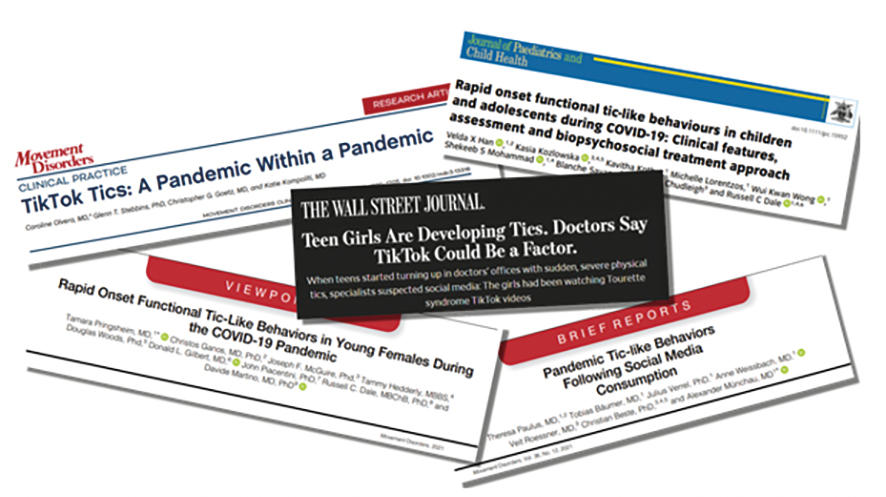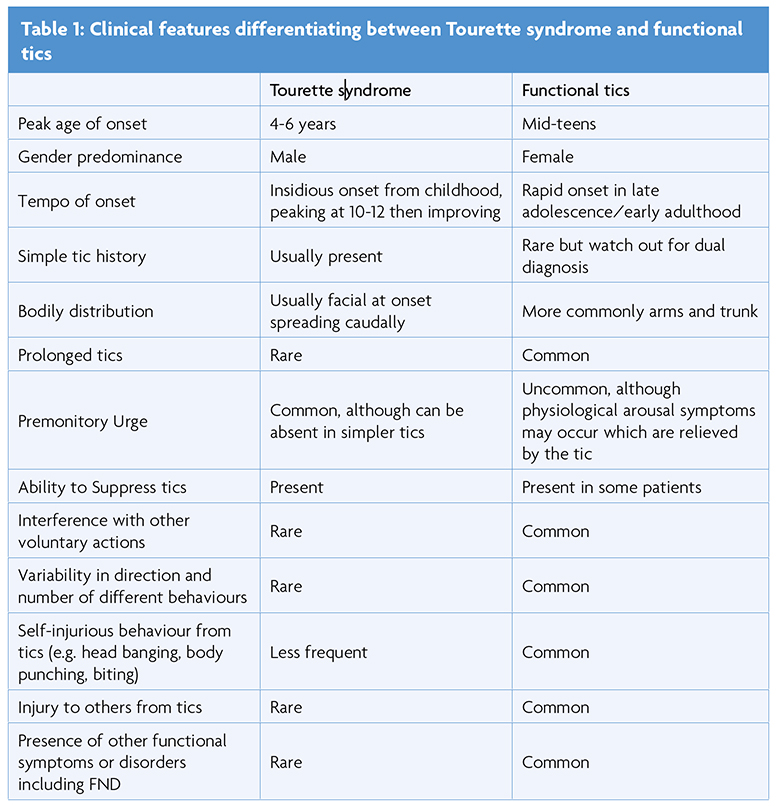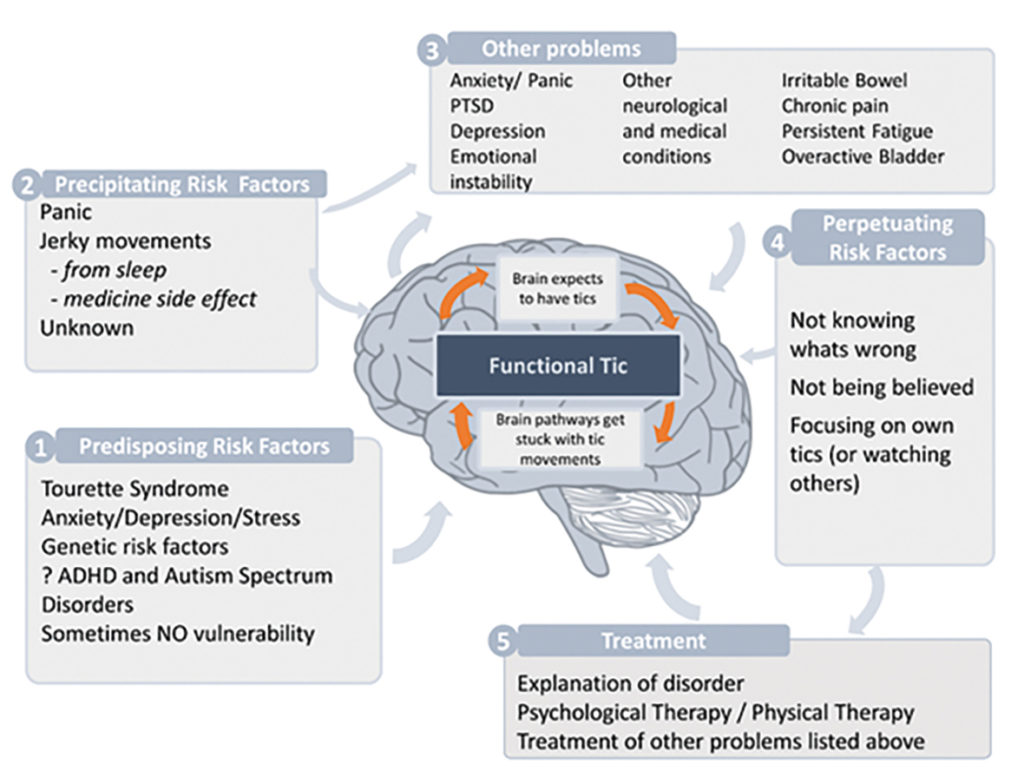Abstract
Functional tics form a part, albeit a small proportion, of the wider spectrum of functional neurological disorders (FND). In this review, we focus on the recent increase in presentations of functional tics since the COVID-19 pandemic. A functional tic disorder is often characterised by rapid onset of complex motor and vocal tics predominantly in adolescent females, distinct from Tourette syndrome which typically begins in younger boys. Rapid onset of severe tics merging into other types of functional neurological disorders, marked coprolalia, self-injury from tics, and school absenteeism, are additional features of functional tics, however, the disorders can co-exist. There has been a lot of focus on social media as an explanation for the rise in cases, although the data suggest that this is just one of many potential factors, with the pandemic itself and its effect on teenage lives being the most likely culprit.
Tics are abnormal sudden, rapid and repetitive movements or vocalisations [1]. Tics can occur as simple vocal/motor tics, as part of Tourette syndrome, as a functional tic disorder (as a subtype of functional neurological disorder) or rarely other neurological conditions. Unlike simple tic disorder, Tourette syndrome requires the presence of both vocal and motor tics lasting for at least 1 year [2] from onset in childhood.
An increase in patients with a functional tic disorder
Tic disorders have been described for centuries with Tourette syndrome characterised in the late 19th century [2]. Functional tics have been described in the context of “hysteria” as early as 1902 [3], but historically have been relatively rare making up 1-5% of new referrals to specialist tic disorder clinics [4], and with only three case series prior to 2019 [5].
Since early 2020 there has been a rise in functional tics, gathering significant attention within the media and literature (see Figure 1) [6]. These typically have affected adolescent females and have been especially noticed by specialist tic clinics. Referrals have risen typically from 1-2% to 20-35% in locations as disparate as Calgary, Sydney, London, and Los Angeles [4].

Differentiating between Tourette syndrome and functional tics
Table 1 summarises some key differences, although clinicians should always consider the possibility of dual diagnosis. The onset of symptoms is a vital discriminator. Tourette syndrome has an average age of onset of 6 years [7] with a significant male predominance. Tics typically start insidiously in contrast with functional tics where there is often a rapid onset typically in late adolescence, and more commonly in females [4].

Tics in Tourette syndrome are initially subtle with intermittent simple motor movements typically in the face that come and go such as repetitive blinking, facial grimacing or sniffing. In comparison, simple tics such as sniffing are relatively absent in functional tics. There is then often a progression to more complex and persistent motor tics in a rostral-caudal pattern from face to arm [7]. This usually develops into more complex multifocal tics involving vocalisation in adolescence, often improving by early adulthood. Tourette syndrome tics are usually preceded by an initial sensory “urge”, an unpleasant sensation usually in the area of the tic, however, it’s important to recognise that most patients with Tourette’s will experience a number of tics without urge (particularly simple tics of the face). The motor or vocal tic often occurs in response to this urge and allows temporary relief. Tourette syndrome tics are not considered completely involuntary as they are normally suppressible to a degree, although the act of suppressing can be unpleasant and associated with rebound worsening.
In functional tics [5] arm movements appear to predominate, in contrast to facial tics in Tourette syndrome. Complex tics and coprolalia appear early, in comparison to Tourette syndrome where these would only occur years after the onset of simple tics. Although people with functional tics do sometimes describe urge and suppressibility, this is less common than in Tourette syndrome. Coprolalia, copropraxia and self-injurious behaviour are rare in Tourette syndrome but occur in up to 50% of patients with functional tics [8]. Functional tics have been noted to commonly lead to significant disability [5], which may involve emergency admission to hospital as well interfering with school or work, again less common with Tourette syndrome.
An important feature to consider is prolonged tics or “tic attacks,” where tics become continuous and sometimes violent. Such episodes are less common in Tourette syndrome as compared to functional tics. These episodes share similar features of hyperkinetic attacks with retained awareness seen in FND that might also be called functional seizures. Functional tics are commonly seen alongside FND, and sometimes functional tics can improve when other FND symptoms worsen, in keeping with functional tics having a different mechanism to Tourette syndrome. It is important to note, however, that people with Tourette syndrome also describe a worsening of tics when “behind closed doors,” such as at home or in a car. This is often a “release” after the effortful suppression of tics in front of others, which can also commonly be called a “tic attack” [9]. This highlights the importance of understanding the phenomenology of a patient’s tic symptoms, with any “tic attack” presentation contextualised alongside the natural history of their tics.
Clinical examination can prove a challenge in discriminating between Tourette syndrome and functional tics, in marked contrast to the differentiation of other functional movement disorders. Features that are useful in differentiating other functional movement disorders such as variability, distractibility and suggestibility are not reliable tests as tics in Tourette syndrome may also have these qualities [5]. Co-occurrence with other functional neurological symptoms is suggestive. Neurophysiological testing may not help either as motor readiness potentials (Bereitschaftspotential) can be present in both, although precede Tourette syndrome tics less commonly [10].
Co-morbid psychiatric pathology is often present in both conditions. Tourette syndrome is a complex neuropsychiatric syndrome commonly associated with OCD and ADHD. Differences exist in those obsessive behaviours seen in Tourette syndrome (in comparison to primary OCD). Obsessions with symmetry, calculation and the “just right” phenomenon are commonplace in Tourette Syndrome but not in functional tics. The presence of anxiety and depression is common to both disorders and is therefore a poor discriminator [11,12].
Evidence for social media influence and the pandemic in the rise of functional tic disorder presentation
In a study before the pandemic, a cohort of patients presented separately with a similar phenomenology of tic disorders to those shared on a well-known YouTube channel [13]. These videos showed complex vocalisations that had been informally attributed to Tourette syndrome, but were more in keeping with functional tics, with patients reporting sudden onset of similar behaviours [13]. This study, however, only selected patients who admitted to exposure to social media, with little focus on other predisposing factors. It should be noted that people with Tourette syndrome do report worsening tics when watching others with tics (echopraxia), as well as sometimes experiencing an influence on the content of vocal tics from others (echolalia).
In a larger study, some centres reported exposure to social media in all their patients, but this was not the case in each centre, highlighting that the link is not absolute [4]. A recent study found that only 18% of 22 patients with functional tics (taken from 185 referrals to their tic clinic over this period) had social media exposure [12].
Social media probably has played a role in the increase of patients with functional tics. The popularity of TikTok has increased significantly since the pandemic with 5.8 billion views of videos with keywords such as #tourette and #tic in March 2021 alone [8]. However, an increase in viewership does not simply infer causality. The individual social media content of tic-like behaviours can be consumed by millions of viewers, however, only a tiny number of patients develop functional tics.
A more nuanced hypothesis has been proposed [12] in which the influence of social media is viewed as playing a part in a wider picture of neuropsychiatric vulnerability. The pandemic and its associated social isolation have involved significant social stressors, especially for teenagers, including issues with academic achievement, domestic confinement, and worsening mental health. These factors could all promote maladaptive habitual movement pathways in the brain, emotional dysregulation, and FND, including tics (Figure 2).

Therefore, with functional tics, and like any patient with FND, having a wider view of the patient and their social setting is key, rather than a more simplistic focus on social media and catchy headlines such as “TikTok Tics”. Overemphasis on social media runs the risk of inadvertently blaming individual patients for “catching” their symptoms through viewing habits. In addition, many patients with Tourette syndrome report an increased stigma towards them as people incorrectly assume that their disorder is also a result of too much social media use.
Management of functional tics
In Tourette syndrome, symptoms tend to improve in late adolescence with cognitive behavioural intervention therapy (CBiT). This includes habit reversal training as a first-line intervention [2]. Medications that are sometimes prescribed in Tourette syndromes, such as clonidine or antidopaminergic drugs such as risperidone or tetrabenazine, should not be used for people with functional tics, highlighting the importance of an accurate diagnosis.
There is little data on the prognosis and treatment of functional tic disorder, but early reports of the outcome, especially in younger teenagers, are encouraging. Like any other form of FND, a clear explanation from a clinician is vital as a platform for being able to engage with and access multidisciplinary treatments. Cognitive behavioural therapy may include strategies to help divert abnormally focused attention away from tics, CBiT may have a role in the management of functional tics. This shares many features with current approaches to physiotherapy and some types of psychological therapy for functional movement disorder. It also seems reasonable to suggest limiting time looking at others with tics in case that is exacerbating it. Treatment of other comorbidities such as anxiety and depression, if present, and liaising with schools and employers to restore more normal activities are also important [10,14].
Conclusion
A functional tic disorder is a distinct subtype of FND that can be associated with marked disability and distress. Differentiating functional tics from Tourette syndrome, and recognising when they may co-exist, has important implications for prognosis and treatment. The increase in cases seen globally may in part relate to exposure to social media use, but the phrase “TikTok Tics” hugely oversimplifies a clinical issue that affects young people who have experienced pressures on physical and mental health during the COVID-19 pandemic.
Resources
- There is a functional tic self-help sheet written by some of the leading experts on tics at http://www.neurosymptoms.org/en_GB/symptoms/fnd-symptoms/functional-tics/
- http://www.tourettes-action.org.uk has useful support information on Tourette syndrome
- The American Academy of Neurology hosted a podcast on this topic: https://directory.libsyn.com/episode/index/id/21928034
References
- Mittal SO. Tics and tourette’s syndrome Drugs in Context. vol. 9. Bioexcel Publishing LTD, 2020. https://doi.org/10.7573/dic.2019-12-2
- Cavanna AE, Seri S. Tourette’s syndrome. BMJ (Online). 2013;347:7922. https://doi.org/10.1136/bmj.f4964
- Meige H, E Feindel E. Les Tics et leur Traitement. Journal of Mental Science. 1902 pp 663-663.
- Pringsheim T et al. Rapid Onset Functional Tic-Like Behaviors in Young Females During the COVID-19 Pandemic. Movement Disorders. 2021;12:2707-2713. https://doi.org/10.1002/mds.28778
- Demartini B, Ricciardi L, Parees I, Ganos C, Bhatia KP, Edwards MJ. A positive diagnosis of functional (psychogenic) tics. European Journal of Neurology. 2015;22(3):527-e36. https://doi.org/10.1111/ene.12609
- Julie Jargon, “Teen Girls Are Developing Tics. Doctors Say TikTok Could Be a Factor.,” Wall Street Journal, New York, Oct. 14, 2021. Accessed: Mar. 30, 2022. [Online]. Available: https://www.wsj.com/articles/teen-girls-are-developing-tics-doctors-say-tiktok-could-be-a-factor-11634389201
- Cohen SC, Leckman JF, Bloch MH. Clinical assessment of Tourette syndrome and tic disorders. Neuroscience and Biobehavioral Reviews. 2013;37(6)997-1007. https://doi.org/10.1016/j.neubiorev.2012.11.013
- Olvera C, Stebbins GT, Goetz CG, Kompoliti K. TikTok Tics: A Pandemic Within a Pandemic. Movement Disorders Clinical Practice. 2021;8(8)1200-1205. https://doi.org/10.1002/mdc3.13316
- Collicott NJ, Stern JS, Williams D, Grabecki K, Simmons H, Robertson MM. Tic Attacks in Tourette Syndrome. Journal of Neurology, Neurosurgery & Psychiatry. 2013;84(11)p. e2.77-e2. https://doi.org/10.1136/jnnp-2013-306573.168
- Ganos C, Martino D, Espay AJ, Lang AE, Bhatia KP, Edwards MJ. Tics and functional tic-like movements: Can we tell them apart?. Neurology. 2019;93(17)750-758. https://doi.org/10.1212/WNL.0000000000008372
- Hirschtritt ME et al. Lifetime prevalence, age of risk, and genetic relationships of comorbid psychiatric disorders in tourette syndrome. JAMA Psychiatry. 2015;72(4)325-333. https://doi.org/10.1001/jamapsychiatry.2014.2650
- Han VX et al. Rapid onset functional tic‐like behaviours in children and adolescents during COVID‐19: Clinical features, assessment and biopsychosocial treatment approach. Journal of Paediatrics and Child Health. Mar. 2022. https://doi.org/10.1111/jpc.15932
- Paulus T et al. Pandemic Tic-like Behaviors Following Social Media Consumption. Movement Disorders. 2021;36(12)2932-2935. https://doi.org/10.1002/mds.28800
- Robinson S, Hedderly T. Novel psychological formulation and treatment of ‘tic attacks’ in tourette syndrome. Frontiers in Pediatrics. 2016;4. https://doi.org/10.3389/fped.2016.00046


